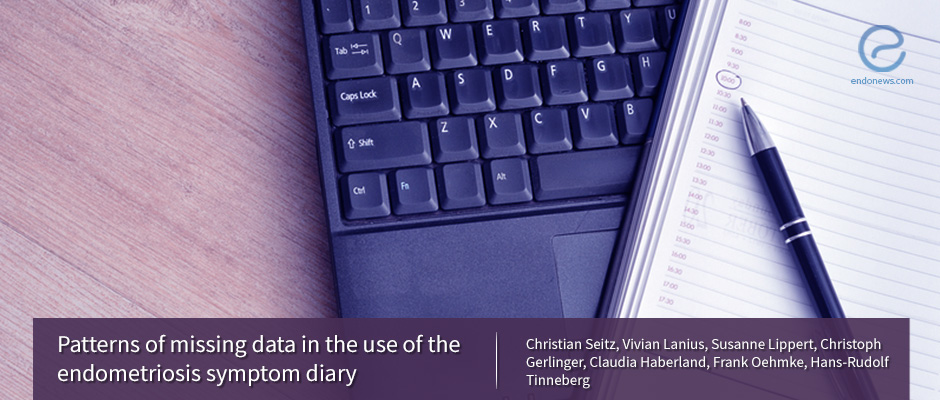Effectiveness of the Endometriosis Symptom Diary
Jun 29, 2018
The Endometriosis Symptom Diary is a new electronic patient-reported outcome instrument that has had positive results with respect to participant use.
Key Points
Highlights:
- The researchers looked for patterns in the data missing from an instrument called the Endometriosis Symptom Diary (ESD), which records a participant’s experience with endometriosis, including symptoms and pain scores. The study being analyzed is the VALEPRO study.
Importance:
- The current patient-reported outcome (PRO) measures that can be used in endometriosis studies do not meet the Food and Drug Administration standards for the industry. As a result, two new PRO measures have been developed, one of which is the ESD, and studies like this one test the instrument in order to assess strengths and weaknesses in the system.
What’s done here?
- Participants
- 272 women with confirmed endometriosis and their full data sets, if available, from the VALEPRO study
- For the VALEPRO study, the participants completed the ESD every day. This procedure lasted at least 12 weeks.
- Information about the ESD
- Has 12 items
- Electronic PRO (ePRO)
- Participants assess 3 main symptoms, delineated below, at its worst in a 24-hour period.
- Pelvic pain, dysmenorrhea, dyspareunia
- 0–10 numeric rating scale (NRS) [0 is no pain; 10 is an unimaginable pain]
- Missing data
- In the VALEPRO study, the participant could not have missing item data, but they could have missing form-level data
- Missing episode is one or more consecutive days without diary entries
- Analyses
- Worst pelvic pain mean score in each missing episode
- The proportion of missing diary entries for each weekday
- The analysis looked at subpopulations as well
Key results:
- Break of missing data from participants:
- No missing entries – 26.5%; 0-5% of entries missing – 46.7%; 5-10% of entries missing – 13.2%; More than 10% entries missing – 13.6%
- Duration of missing entries
- 1 day – 81.4%
- Weekday of missing episode
- Friday – 18.5%; Saturday – 22.9%
- The country with longer missing episodes, defined as more than 1 day, was the United States. The proportion per country is:
- United States – 22.6%; Germany – 10.5%
- Longer missing episodes, defined as more than 1 day, per education level is as follows:
- Elementary education – 50.0%; Secondary education – 70.2%; College or University education – 79.8%
- Proportions of women with longer missing episodes, defined as more than 1 day, did not differ depending on whether or not the participant had children. The data for this measure is as follows:
- With children – 72.2%; Without children – 74.3%
- The difference in missing and complete episode worst pain mean scores was -0.1 per participant. The authors say that this suggests that the severity of pain was not responsible for the missing episodes
Limitations of the study:
- The authors listed the following as potential limitations for the study:
- VALEPRO only included participants from two countries
- The study was non-interventional so it did not have a lot of participants with changes in their endometriosis severity
Lay Summary
Seitz et al., a research group from Bayer AG and the University of Giessen, recently published an article titled “Patterns of missing data in the use of the endometriosis symptom diary” in BMC Women's Health. The authors were analyzing data from the VALEPRO study. The study used an electronic patient-reported outcome (ePRO) instrument called the Endometriosis Symptom Diary (ESD). The researchers from this study looked for patterns of missing data and wanted to elucidate the factors that led to the loss of the data in the first place.
The researchers conducted post hoc analyses. The VALEPRO study had 272 participants, which were women with endometriosis. The participants were to use the ESD to record their endometriosis symptoms from a 24-hour period. A numerical rating scale was used to score the various symptoms. Missing episodes were defined as one or more days where the participants did not enter information into the ESD. The data was subject to analyses.
Nearly half of the participants had 0-5% of entries from the ESD missing. The majority of missing episodes were only 1 day in length. Most missing episodes were on Fridays or Saturdays and participants in the United States were more likely to have longer missing episodes than their contemporaries in Germany. Women with college or university education were more likely to have missing episodes that last longer than a day compared to women who had an elementary or secondary education. Researchers found similar results in terms of proportions of missing episodes longer than a day for women with and without children. The participants were not found to have missing episodes depending on the severity of their pain. Overall, participants were likely to use the ESD to record their experiences with the disease.
Research Source: https://bmcwomenshealth.biomedcentral.com/articles/10.1186/s12905-018-0578-0
electronic patient-reported outcome Endometriosis Symptom Diary VALEPRO

